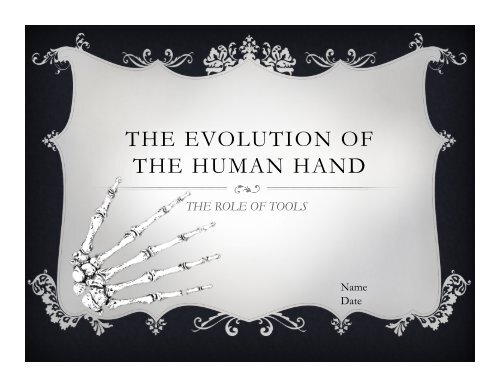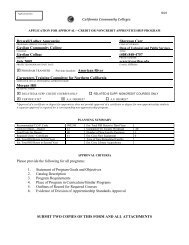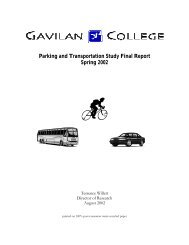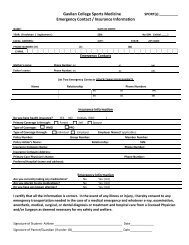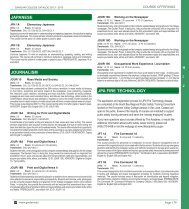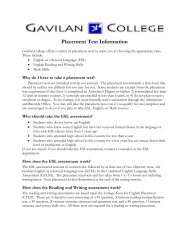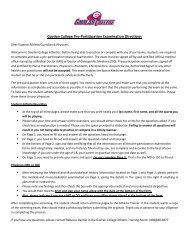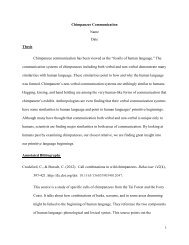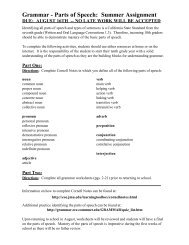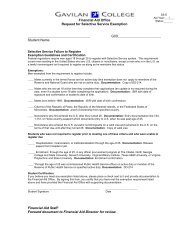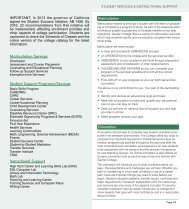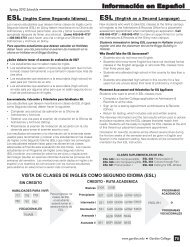THE EVOLUTION OF THE HUMAN HAND
THE EVOLUTION OF THE HUMAN HAND
THE EVOLUTION OF THE HUMAN HAND
You also want an ePaper? Increase the reach of your titles
YUMPU automatically turns print PDFs into web optimized ePapers that Google loves.
<strong>THE</strong> <strong>EVOLUTION</strong> <strong>OF</strong><br />
<strong>THE</strong> <strong>HUMAN</strong> <strong>HAND</strong><br />
<strong>THE</strong> ROLE <strong>OF</strong> TOOLS<br />
Name<br />
Date
<strong>THE</strong> GREAT DEBATE<br />
Since the discovery of fossil hand bones of our human ancestor Homo habilis<br />
alongside core tools at Olduvai Gorge in the early 60’s, the evolution of the human<br />
hand has been a source of great speculation and debate (Marzke 1). There have<br />
been many theories as to how and why the hand evolved the way it did, however<br />
there appears to be one dominate and most plausible theory: the role and use of<br />
tools in our early ancestral culture. It is proposed that it was tools that<br />
revolutionized the human hand, fueling the evolution that has produced the modern<br />
human hand. This presentation will give insight into how the human hand has<br />
evolved and how the role of tools influenced this evolution.
JUST WHAT HAS HAPPENED?<br />
To understand how these changes have unfolded, it is important to first<br />
understand exactly WHAT changes have taken place. To do so, we will<br />
take a look at the distinguishing factors of the modern human hand, the<br />
functioning they serve and how they apply to tool making. Once we<br />
understand the changes and the purpose they served, we will discuss how<br />
this remodeling of the human hand was made possible by the<br />
reproductive advantages it allowed. Finally, we will discuss the variable<br />
factors we must consider for this theory to be true.
DISTINCT FUNCTIONING<br />
According to Dr. Mary W.<br />
Marzke of the Arizona<br />
State University<br />
Department of<br />
Anthropology, the<br />
functions that make the<br />
human hand so distinctive<br />
are the ability to firmly<br />
grasp objects and cup the<br />
hand around them in a<br />
manor that increases<br />
precision and<br />
maneuverability (Marzke<br />
1). It is this same precision<br />
and maneuverability that<br />
allows us to engage in<br />
more advanced tool<br />
making activities. Also,<br />
although not as advanced<br />
in comparison, it was the<br />
evolution of the<br />
mechanisms that provide<br />
us with these abilities that<br />
allowed our ancestors to<br />
engage in core tool<br />
making. In the following<br />
slides we will take a<br />
comprehensive look at the<br />
areas of the hand that have<br />
evolved to allow this.
<strong>THE</strong> MODERN <strong>HUMAN</strong> <strong>HAND</strong><br />
The features of the<br />
modern human hand that<br />
allow such unique<br />
precision and<br />
maneuverability for tool<br />
making can be summed<br />
up in 6 main points. For<br />
greater understanding of<br />
these distinctions, I will<br />
highlight the areas<br />
mentioned on the<br />
following diagram.
DEFINING ANATOMICAL FEATURES<br />
OPPOSABILITY AND LENGTH <strong>OF</strong> THUMB<br />
Opposability, the ability to<br />
touch ones thumb to the<br />
fingertips of all fingers on<br />
the same hand, is indeed a<br />
trait we share with the<br />
apes; however, it is an<br />
essential to our ability to<br />
cup and grip items firmly<br />
in order to manipulate<br />
them (Marzke 123).<br />
According to Dr. Richard<br />
W. Young of the<br />
University of California,<br />
the human thumb also<br />
displays greater mobility<br />
in comparison to other<br />
primates (Young 165). In<br />
addition, the human<br />
thumb has larger muscles<br />
and the presence of the<br />
flexor pollicis longus<br />
muscle<br />
which is absent in chimps<br />
(Young 167). These<br />
muscles provide added<br />
strength and control to<br />
thumb movement (Young<br />
167) .Another factor that<br />
makes the human thumb<br />
distinct from other<br />
primates is the fact that in<br />
proportion to the rest of<br />
the hand, the thumb is<br />
much longer in<br />
comparison with other<br />
primates (Young 165).
DEFINING ANATOMICAL FEATURES<br />
COMPLEXITY IN <strong>THE</strong> WRIST<br />
Within the modern<br />
human wrist there<br />
exists many<br />
complexities; however,<br />
for the purpose of<br />
grasping for tool<br />
making, there is two<br />
aspects of the wrist<br />
that are especially<br />
significant. First, the<br />
base of the second<br />
metacarpal is<br />
extremely complex,<br />
allowing connectivity<br />
to three carpal bones,<br />
the trapezium, the<br />
trapezoid and the<br />
capitate (Markze 123).<br />
This compound<br />
connectivity allows<br />
for pronunciation of<br />
the metacarpal (123).<br />
Also, the broadness<br />
of the trapezoid and<br />
capitate in association<br />
work to relieve the<br />
stresses that form due<br />
to the opposition of<br />
the thumb to the<br />
fingers during<br />
manipulation of<br />
itemry (Marzke 123).
DEFINING ANATOMICAL FEATURES<br />
MARKED ASYMMETRY<br />
A feature that is<br />
vital to the ability<br />
to grasp firmly and<br />
efficiently during<br />
tool making is<br />
made possible by<br />
the distinct shapes<br />
of the second and<br />
fifth metacarpal<br />
heads (Marzke<br />
123). The fact that<br />
these two<br />
metacarpals have<br />
heads that are<br />
asymmetrical to each<br />
other and have<br />
distinct projections<br />
on the outer areas<br />
enables these fingers<br />
to rotate toward<br />
each other during<br />
flexion of tendons<br />
(Marzke 123). This<br />
reciprocal motion<br />
permits the hand to<br />
form around an item<br />
and grip more firmly<br />
for manipulation.
DEFINING ANATOMICAL FEATURES<br />
AN AID IN ROTATION<br />
Contributing to that<br />
reciprocal rotation<br />
between the second<br />
and fifth metacarpals<br />
and therefore<br />
contributing to the<br />
overall strength and<br />
precision of the grip<br />
it provides for is a<br />
unique saddle joint<br />
between the fifth<br />
metacarpal base and the<br />
hamate (Marzke 123).<br />
This saddle joint also<br />
permits greater rotation<br />
for connectivity of the<br />
fifth phalange to the<br />
thumb (Bade 116). This<br />
increase in range<br />
provides greater overall<br />
dexterity (Bade 120).
DEFINING ANATOMICAL FEATURES<br />
SHORT <strong>HAND</strong>S<br />
As you can see from figure<br />
1 of Dr. Young’s<br />
publication, when<br />
compared to a chimp hand<br />
(a model for our hominid<br />
ancestors) a significant<br />
amount of digital and pad<br />
shortening can be seen in<br />
the human hand (Young<br />
166). This shortening<br />
provides greater stability<br />
and better stress endurance<br />
(Young 167).
GETTING A GRIP ON TOOL MAKING<br />
TWO KINDS <strong>OF</strong> GRIPS<br />
These evolved sections allow the human hand to grip in two distinct ways<br />
vital to the tool making process. According to Dr. J.R. Napier, with these<br />
advancements, the human hand can accomplish two types of grips, the<br />
precision grip and the power grip (Napier 903). The power grip is<br />
characterized by a clamp like formation in which the fingers and the palm<br />
are partly flexed and counter pressure is applied by the thumb which is in a<br />
position even to the palm (Napier 903). The main objective of this grip in<br />
terms of tool making/using strategies is to absorb impact without injuring<br />
the user, prevent the object from exiting the hand and allow for immediate<br />
restrike (Young 170). The precision grip is accomplished when the object<br />
is pinched between the flexors of the fingers and the thumb which<br />
parallels the middle and distal phalanges (Napier 903). In regards to tool<br />
making and using, this grip is meant to increase precision in throwing, and<br />
allow for a firm yet accessible grip on an object (Young 169). These two<br />
types of grips have also commonly been referred to as the cylinder (power)<br />
and ball (precision) grips.<br />
This image from Napier’s article displays the two grips (Napier<br />
903).
GETTING A GRIP ON TOOL MAKING<br />
Now that we understand the grips evolution has allowed, lets take<br />
a look at how they apply to primitive tool making. As you can see<br />
from figure 11.3 of our course text “Biological Anthropology” by<br />
Michael Alan Park, both precision and power grips were necessary<br />
to make core tools like the ones found at Olduvai Gorge (Park<br />
266). The hand containing the hammerstone is held in a way that<br />
is reminiscent of the power grip, probably in order to control the<br />
striking point and absorb shock, core too is held in a clamp-like<br />
power grip in order to absorb shock without the stone exiting the<br />
hand on impact. The use of these core tools would also have been<br />
impossible without the ability to power grip in the case that they<br />
were used for clubbing and in the case they were used for<br />
throwing to strike an enemy they would have needed precision<br />
grip. These wouldn’t have been the only tools these grips were<br />
vital to, as Young stresses, these grips were also necessary to wield<br />
clubs, and throw stones and other weapons (Young 165).<br />
GRIPS IN ACTION
AN ADVANTAGE IN REPRODUCTION<br />
As we all learned this semester, evolution takes place when a trait causes a<br />
reproductive advantage and is selected for, but just how does this apply to hand<br />
evolution through tools? The answer can be found when we look at the culture<br />
of our more primitive ancestors. As Young notes, males who were highly<br />
aggressive and skilled with weapons like clubs, were the most likely to rise in<br />
dominance hierarchy and gain better access to resources (Young 165). These<br />
resources would include the food and water that insured survival as well as<br />
access to more females for breeding. In males, the most skilled weapons users<br />
were most likely the ones that possessed certain variations within the hand that<br />
better enabled them to use their weapons effectively. In females, possessing<br />
these variations would better enable them to protect their young and<br />
themselves by warding off predators with weaponry, therefore being more likely<br />
to pass on these traits to other generations. (Young 166). With time, the variable<br />
traits that allowed the maximization of use of tools of protection would have<br />
been selected for and accumulated to produce the modern human hand as we<br />
know it.
VARIABLES TO CONSIDER<br />
IT MUST BE TRUE<br />
As viable as this theory seems, there are factors that need to be accounted for in<br />
order for this theory to be true. First, due to limited hand fossils from few hominid<br />
species, the information available is qualitive not quantitive (Marzke 126). Also, not<br />
all of these features have been statistically analyzed for distinct effectiveness in the<br />
functioning they provide (Marzke 126). Similarly, experimentation of the<br />
manipulative advantages of these gripping features are fairly limited (Marzke 126).<br />
Even with these factors in consideration, the likelihood that the information that<br />
has been gathered until present proves this theory is very high; making sense of the<br />
fact that this theory is most accepted.
IN CLOSING<br />
As complex and efficient for tool making and use as the human hand is now, it<br />
wasn’t always this way. The modern human hand and its comprehensive gripping<br />
capabilities are the result of millions of years of evolution by selection. It is<br />
interesting to see that a culture of tools and aggression has produced such a<br />
complex appendage. This also raises many questions such as “Will future<br />
anthropological finds disprove this theory, or confirm it?” and “How will our<br />
current culture and modern tools like cell phones and computers effect the future<br />
evolution of the human hand?”. Lets not wait for the future to answer these<br />
questions, after all, it is the past that truly holds the key.
WORKS CITED<br />
Bade, H, J Koebke, and H Bilger. "[Functional anatomy of the fifth carpometacarpal joint].“ Handchirurgie, Mikrochirurgie,<br />
Plastische Chirurgie: Organ Der Deutschsprachigen Arbeitsgemeinschaft Für Handchirurgie: Organ Der<br />
Deutschsprachigen Arbeitsgemeinschaft Für Mikrochirurgie Der Peripheren Nerven Und<br />
Gefässe: Organ Der Vereinigung Der Deutschen Plastischen Chirurgen 25.3 (1993): 116-120. Web. 18 May 2011.<br />
Marzke, Mary W., and R. F. Marzke. "Evolution of the Human Hand: Approaches to Acquiring, Analyzing and Interpreting<br />
the Anatomical Evidence." Journal of Anatomy 197 (2000): 121-40. Print.<br />
Napier, J. R. "The Prehensile Movements of the Human Hand." The Journal of Bone and Joint Surgery 38B.04 (1956): 902-13.<br />
Print.<br />
Park, Michael Alan. "The Evolution of Genus Homo." Biological Anthropology. 5th ed. Boston: McGraw Hill, 2008. Print.<br />
Young, Richard W. "Evolution of the Human Hand: the Role of Throwing and Clubbing." Journal of Anatomy 202.1 (2003):<br />
165-74. Print.


